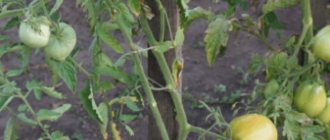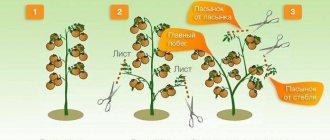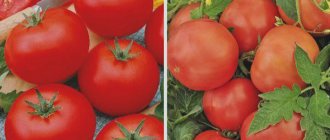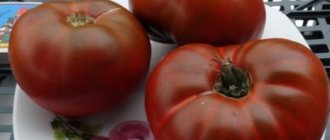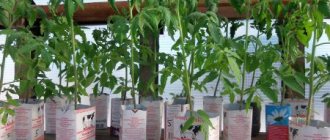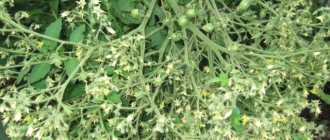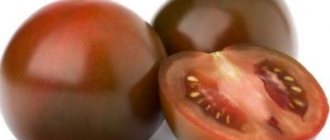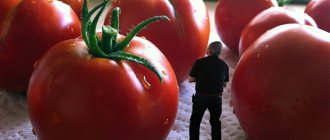Vegetable growing » Tomatoes
0
1602
Article rating
Kira Stoletova
There are many different types of tomatoes, each of them differs from each other in its characteristics and qualities and, most importantly, in yield. The Slivovka tomato is a relatively new and interesting species that was created using hybridity.
Description of tomato Slivovka
Secrets of Bountiful Harvests
To enjoy fresh tomatoes throughout the year, you should plant varieties with different fruiting periods.
Plum-shaped tomatoes with small fruits grow well on a windowsill in winter, followed by greenhouse representatives of larger sizes with early and medium ripening periods. Many of them bear fruit until frost. Whatever varieties and hybrids are chosen, all are grown through seedlings. March days are best for sowing plum tomato seeds.
The initial stage of cream tomatoes in Russian regions is no different from other varieties and hybrids. Sow seeds in soil rich in nutrients and set up a mini-greenhouse. The room temperature is maintained at least 25 degrees.
Good lighting (at least 14 hours of daylight) and timely feeding will allow tomato seedlings to develop well. Pale leaves and thin, elongated stems will signal a lack of light. Strong bushes with several true tomato leaves dive into separate pots.
The second stage is the active development of the tomato bush. During this period, the plant receives moisture and nutrition. The watering regime must be treated with particular care. Excess water provokes fungal infections in plum tomatoes. Loosening, mulching the soil and airing allow you to regulate the level of humidity around the seedlings. The optimal air humidity for plum tomatoes is 50-60%.
The third stage of tomato development is the planting of bushes in the ground in a permanent place immediately after spring frosts, usually mid-May or early June. By this time, the seedlings already have a developed root system, a strong trunk with a crown of several leaves. The planting pattern for plum tomatoes is checkerboard, the interval between holes depends on the dimensions of the future bush.
Every 14 days, tomato plantings are fertilized with complex compounds containing phosphorus and potassium. Nitrogen fertilizing is applied before flowering, so that the plant does not actively begin to grow its crown instead of fruits.
Warning! Late blight is the main enemy of plum-shaped varietal tomatoes. It is imperative to treat the bushes.
The bushes need a lot of sunlight. Lack of light will lead to loss of flower stalks and crops.
The fourth stage is the most enjoyable - harvesting. At this point, if there was enough light, nutrition and moisture, the tomato bushes look healthy, with beautiful, even, tasty tomatoes of the expected size hanging on them.
The temperature inside the greenhouse should not rise above 30 degrees. Pollen is sterilized at such temperatures and there will be no ovaries.
The temperature when growing tomatoes in greenhouses is regulated by ventilation, mulching the soil, and not watering. Watering should be regular and moderate. The volume of moisture increases slightly during the period of active fruit filling. Excess water will lead to shedding of flowers and ovaries, and very rarely to cracks in tomatoes.
Following simple rules will allow you to harvest an enviable harvest of plum tomatoes.
Features of care
Despite the unpretentiousness of the Slivovka variety, to achieve high yields, agrobiologists recommend following the basic rules of plant care:
- You should start germinating seeds in mid-March, but no later than the 20th. At the germination stage, seedlings require moderate and regular watering, ventilation and illumination with ultraviolet lamps.
- Agronomists recommend hardening off newlywed Slivovka bushes before transplanting them into open ground.
- For rapid growth and development of seedlings, it is time to use biostimulants.
- It is recommended to introduce mineral or organic fertilizers into the soil at the dacha before planting seedlings.
- It is prohibited to grow tomatoes for 2 summers in a row in one place.
- Young bushes of Slivovka need picking after the appearance of 2 true leaves.
- The bed on which it is planned to grow tomatoes should be prepared in the fall. Transplanting seedlings to a permanent place of growth is only possible after the end of frost. During transplantation into the garden, young plants need a large amount of nutrients. Natural fertilizers will help ensure their presence.
- Agronomists recommend not to give up mulching the soil. Observe moderate watering, without over-wetting the soil, regularly loosen the soil.
- Amazing time of ovary formation and fruit formation, mineral fields should be introduced).
- It is necessary to remove weeds in a timely manner to prevent their growth. They provoke soil oxidation and threaten the health of tomatoes.
Description of the Slivovka tomato variety and its characteristics
Gardeners are not delighted with the taste of store-bought tomatoes: they want to try growing their own. Reviews about the Slivovka tomato are encouraging. The fruits will have time to fill before the weather gets colder. The leftovers will ripen in a warm room.
Features of Slivovka
Agrobiologists are trying to satisfy the needs of gardeners. They are working on new varieties and improving their performance. The result: heat-loving tomatoes ripen outdoors in areas with short, hot summers.
https://youtube.com/watch?v=0gjVaMLfkE0
Characteristics and description of the Slivovka tomato variety:
- ripens well in open ground;
- limited in growth (maximum 40 cm) variety;
- early ripening period (the period from loops to tomato sampling is 100 days);
- slightly leafy plant, bright green plates;
- friendly ripening of fruits;
- the bush does not need to be tied up, shaped, or pinched;
- yield 8 kg/m² (subject to planting and care rules);
- not affected by blossom end rot or septoria.
The tomato is unpretentious. Sets fruit in cool and hot weather. Those who planted Slivovka appreciated the resistance of the seedlings to stretching.
What's ripening in the garden beds
Gardeners want to eat tomatoes from the garden early. The Slivovka tomato produces delicious berries in mid-July. Description and appearance of the fruit:
- smooth to the touch;
- the shape resembles a plum with a thin “spout”;
- flattening of the stalk;
- grows up to 120 g;
- the pulp is fleshy, low-juicy;
- the skin is dense, tough in dry summers;
- the taste is sour;
- ripe fruits are deep red;
- the stalk is easily separated (in ripe fruits);
- the berries are resistant to cracking.
Gardeners know: grown in their own beds, the Slivovka tomato looks beautiful in canned vegetables. High acidity ensures the safety of homemade preparations.
Why is Slivovka valued?
Stores present seeds of varieties and hybrids for every taste. Among gardeners growing tomatoes, Slivovka found admirers. She is appreciated for:
- absence of whims;
- disease resistance;
- stable formation of ovaries in any weather;
- friendly return of fruits;
- excellent transportability.
Gardeners are confident that whoever grows the Slivovka tomato will provide himself with delicious canned vegetables for the whole winter. Picked brown, the fruits will remain in the pantry until October.
How to make your dream come true
The variety is unpretentious. It is not difficult to achieve the specified yield. It is worth following the recommendations of agrobiologists:
sow for seedlings no later than March 20; pay attention to soil fertility; observe crop turnover; pluck seedlings when 2 true leaves grow; highlight, ventilate, temper, feed; prepare the landing site in advance (in autumn); place in permanent beds after the end of spring frosts; To strengthen the tomatoes, feed them when planting; the plant overloads itself with fruits: the soil should be mulched; follow the rule: it is better to dry it than to overwater it; feed with mineral complexes. Planting oats, rye, and wheat will help improve the health of the land.
You should wait for seedlings, dig and embed them in the soil
Planting oats, rye, and wheat will help improve the health of the land. You should wait for the shoots to emerge and dig them into the soil.
Evaluation of varieties by gardeners
The summer resident complains: she planted Slivovka in the greenhouse. She fed, watered, ventilated. The bushes are stretched, fattening, there are few tomatoes. Not surprising: the variety is designed for reactive fruiting in short summers. Other conditions are not suitable.
A gardener from the Moscow region: “We plant Slivovka in May under film. We cover the beds with straw. After frost we remove the cover. All! All that remains is to eat tomatoes. We roll them whole into jars and eat them fresh. At the end of July we collect the remains. They ripen well at home. We eat tomatoes until the beginning of November.”
Moscow region beds
In each region of Russia, summer residents have their own favorite varieties of tomatoes. If you consider the characteristics and description of the tomato variety Slivovka and others in the table below, you can understand why they are so attractive to gardeners in the Moscow region.
Tomatoes popular in the Moscow region
| Variety | Peculiarities |
| Slivovka | · An extra-early variety that produces a nice cream with a “spout.” The red fruits are smooth, slightly flattened at the stalk. They have low-juicy, fleshy pulp and a sour taste; |
| · Gardeners are attracted by its unpretentiousness, good immunity, the formation of ovaries, regardless of weather conditions, and the friendly yield of the harvest; | |
| · The fruits are marketable and transportable. If you pick them up from the bush when they are brown, they will rest quietly in the cellar until the beginning of winter. Good at preserving | |
| Cream Honey Tomato | · The hybrid variety is represented by determinate standard bushes. Despite their early maturity, they are grown not only in open ground, but also in greenhouses; |
| · The smooth red fruit with fleshy pulp has high tasting qualities and a pleasant aroma. A special feature of the Honey Cream tomato is the small number of chambers with seeds; | |
| · With tomatoes weighing up to 70 g, you can get about 4.5 kg from one square meter; | |
| · The variety is characterized by the following qualities: cream marketability, disease resistance, stable yield | |
| Moscow | · This is not just a variety - under this name there are several varieties of the crop, differing in color shades. The most popular among farmers are chocolate and yellow; |
| · Slivka Moskovskaya tomatoes have a sweetish taste with a slight piquant note, which allows the variety to be used more often than others for making ketchups and sauces; | |
| · The fruits are elastic, with low moisture content and a high percentage of glucose. At the time of ripening, tomatoes reach a weight of 130 g, which ensures good yield; | |
| · The variety is unpretentious to growing conditions, but has weak immunity to fungal diseases | |
| lady finger | · Determinate bush, up to 1 m high, bears fruit 3.5 months after planting. Graceful tomatoes are shaped like their name. Elongated tomatoes grow up to 8 cm in length and gain an average mature weight of 140 g; |
| · From one square meter, using conventional agricultural technology, a summer resident collects up to 6 kg of elastic fruits with a glossy skin. They are suitable for long-term transportation, retain marketability for a long time and have good taste. |
Having studied all the characteristics of tomatoes, gardeners select those that they like most. When choosing varieties for open ground, the emphasis is on regionality, because for areas with a short growing season you should not choose late-ripening Cream.
Tomato "Large Cream"
Description
This variety is one of the characteristic representatives of the tomato cream family. In addition, it does not have any special care requirements, so even a beginner can grow it.
It is absolutely universal - it will grow equally well both in open ground and in greenhouse conditions. It can even be successfully grown in containers on balconies and window sills. It is distinguished by abundant fruiting; tomatoes collected at the stage of technical maturity ripen well in room conditions. It also stores well in a dark and cool place.
The Large Cream variety is a determinate, standard, compact, low bush. It is distinguished by early ripening; fruits can begin to be collected at the end of June. Plant height is from 40 to 60 cm. The fruits are oval with a pointed tip, orange-red in color. The average weight of a tomato of this variety is 70-90 g. The taste is moderately sweet and pleasant. The pulp is elastic, juicy, with small seed chambers. Productivity is high. The skin is dense and preserves tomatoes well during canning. Tomatoes also store well and are suitable for transport over long distances.
Tomato Large cream
Advantages and disadvantages
The main advantages of the Large Cream variety are as follows:
- Versatility
- Unpretentiousness
- Does not require pruning or garter
- High yield
- Early and simultaneous ripening of tomatoes
- Resistance to major diseases (fusarium, late blight, root rot, etc.)
This variety has the following disadvantages:
- A bit bland taste
- Demanding about fertilizing and watering.
Thus, cream tomatoes are distinguished, on the one hand, by their huge variety, allowing everyone to find something to their taste, and on the other hand, by their general unpretentiousness and high yield, which will help in almost any climatic conditions to obtain a decent harvest of tomatoes. And the versatility of using the fruit makes cream tomatoes attractive to any gardener, both beginner and professional.
We invite you to join our group on VKontakte or Odnoklassniki, where new articles are published, as well as news for gardeners and livestock farmers.
The most productive varieties of cream tomatoes
When canning or selling cream tomatoes, yield plays an important role in choosing a variety. Below are the highest-yielding cream tomatoes, the seeds of which are sold everywhere.
Rio de Grande variety
- "Rio de Grande" have a high yield and produce 8-10 kg of fruit per square meter per season. Bushes of this variety grow up to 60 cm in height. A garter is necessary only when the bushes fall under the weight of the fruit. Tomatoes in the form of cream, weighing about 115 g. Purpose is universal, the taste is sweetish.
- “Sugar plum raspberry” is a variety of Russian selection. Productivity up to 8 kg/m. sq. The ripening period is only 87-95 days. It is grown in greenhouses and in open ground. Grows up to 1.4 meters in height and needs staking. The fruits are up to 25 grams, plum-shaped, red-raspberry, with a small amount of seeds and a high content of vitamins. Transportable, universal use. The taste is delicate and sweet, children really like it.
Variety Chio chio san
- "Chio chio san" is grown exclusively on trellises, as it reaches a height of 2 meters. Productivity is approximately 8-12 kg/m. sq. Ripening occurs in 100-120 days. The fruits are pink-red in color and average weight is 35 grams. The cluster is branched, with elongated stalks, so the fruits seem to be scattered on the plant. Cream tomatoes of this type have increased resistance to disease. Used for fresh consumption and whole salting.
- "Roma" has a quite acceptable yield of 6.5-7.3 kg/sq.m. Belongs to the mid-season group of tomatoes. The fruits are collected in clusters of 10-20 pieces and ripen together. The fruits are red, up to 100 g. The plant is not very tall, semi-spreading. Tomatoes are elastic, the skin is dense, they can be transported over long distances, and they have excellent commercial qualities. Suitable for processing; when fresh, they may seem a bit dry.
Agricultural technology of tomatoes Cream
This variety is grown according to the same principle as any other tomato variety - in seedlings.
Productivity primarily depends on the quality of the seeds used:
- They should not be hollow, which is easy to check by immersing them in a saline solution. Full-bodied seeds will sink to the bottom, and those that float should be discarded;
- Deformed seeds are also not used - they will produce low-quality seedlings;
- To prevent diseases, seeds are disinfected by immersing them in a solution of hydrogen peroxide or potassium permanganate for 10 minutes.
Note! To speed up germination, after planting the seeds, it is recommended to cover the soil in the seedling box with a damp cloth. The soil should also be disinfected and then fertilized
To avoid excess moisture, containers for seedlings are chosen with drainage holes. 2 months after sowing, seedlings can be sent to the beds using a standard step-by-step planting algorithm
The soil should also be disinfected and then fertilized. To avoid excess moisture, containers for seedlings are chosen with drainage holes. 2 months after sowing, the seedlings can be sent to the beds using the standard step-by-step planting algorithm.
When caring for cream, special attention is paid to fertilizing. Experienced summer residents offer several options for nutrient mixtures to which this variety of tomatoes is responsive.
Fertilizers for tomatoes Cream
| Application period | Composition (per 10 liters of water) |
| The beginning of June | · Mullein – 5 l, boric acid – 3 g, nitrophoska – 1 tbsp, microfertilizers – 2 tablets; |
| · 0.8 kg of fertilizer is applied to each bush | |
| First week of July | Mullein and microfertilizers are mixed with potassium sulfate (1 tbsp.) |
| Weekly | Weak solution of manganese (5 g crystals) |
| After harvest | 2 kg of organic matter per 1 sq.m. plot (compost or manure) – without diluting with water |
Organic fertilizers are applied to the soil in the fall when digging the area prepared for planting tomatoes next year.
Watering
Cream varieties do not like dry weather, so they need to be watered regularly. But excess moisture is not allowed - this is harmful to the root system. Therefore, during the rainy season and in cool weather, watering is not carried out.
Drip irrigation of tomatoes
The water should be warm enough so that the plants do not get sick. Only the soil around the trunk is watered. To prevent moisture from getting on the foliage and fruits, it is advisable to equip the beds with drip irrigation.
Diseases
On a note! Not all varieties of Cream are disease resistant. To get rid of fungi and bacteria, it is recommended to treat the bushes with Fitosporin, Fundazol, Ridomil. When the first signs of the disease are detected, limp and affected leaves and stems must be removed immediately. To reduce the risk of damage, tomatoes should not be planted next to or after potatoes.
Secrets of a good harvest
This variety of tomato produces an excellent harvest, but it can be significantly increased by following some recommendations:
- young seedlings must be fed with special liquid fertilizers;
- during transplantation into the ground, it is advisable to treat the root system with special means for better rooting;
- you should not bet on weak seedlings; careful selection of plants will ultimately help you get a much better result;
- It is optimal to use a drip irrigation system or apply water to each bush in doses;
- Mulching of bushes is carried out with freshly cut grass, straw or hay.
Features of Slivovka
Agrobiologists are trying to satisfy the needs of gardeners. They are working on new varieties and improving their performance. The result: heat-loving tomatoes ripen outdoors in areas with short, hot summers.
https://youtube.com/watch?v=0gjVaMLfkE0
Characteristics and description of the Slivovka tomato variety:
- ripens well in open ground;
- limited in growth (maximum 40 cm) variety;
- early ripening period (the period from loops to tomato sampling is 100 days);
- slightly leafy plant, bright green plates;
- friendly ripening of fruits;
- the bush does not need to be tied up, shaped, or pinched;
- yield 8 kg/m² (subject to planting and care rules);
- not affected by blossom end rot or septoria.
The tomato is unpretentious. Sets fruit in cool and hot weather. Those who planted Slivovka appreciated the resistance of the seedlings to stretching.
Vegetable growers' opinion
Some gardeners complain about the inability to grow the Slivovka variety in a greenhouse: “I planted the seedlings in the greenhouse and barely saw the harvest. The bushes grew and developed well, but they didn’t even begin to bloom.” Agrobiologists have developed a variety for high-speed fruiting in open ground conditions; due to this, it is not capable of bearing fruit in greenhouse conditions.
When grown in proper conditions, vegetable growers speak about the variety in reality: “We plant the bushes in May and cover them with film until it warms up. There is no need to make any more efforts to ensure a good harvest. The popularity of the Slivovka variety is increasing every year. Gardeners assure us that it is democratically impossible to refuse to grow these tomatoes once they have been planted.
Description of plum tomato
Early ripening low-growing (35-40 cm) determinate variety. The fruits are red, plum-shaped, weighing 80-100 g, used fresh, but are especially good for whole-fruit canning.
It is grown in 2-3 stems, possibly without pinching, in open ground. The value of the variety is its early ripening, stable productivity, original plum-shaped shape and unsurpassed pickling qualities of the fruit.
The variety is resistant to adverse weather conditions. The variety responds well to watering and fertilizing with complex mineral fertilizers.
The quality of the seeds complies with GOST and is confirmed by a certificate!
5 Amazing reasons why you should buy seeds from us:
- The seeds are of excellent quality and have a long shelf life. Make sure by checking germination!
- We hold regular promotions and discounts.
- When purchasing over 3,000 rubles, we will deliver the seeds absolutely free!
- Premium class cucumber “Siberian Garland” for 0 rubles, when ordering seeds from 2000 rubles.
- If you are not satisfied with anything about our seeds, feel free to write to us, we will return your money!
American selection tomatoes
We invite you to familiarize yourself with the varieties of tomatoes from America.
Shakira
This is a new hybrid that is distinguished by meaty tomatoes that have an excellent taste. Since the skin of the vegetable is dense, it resists cracking. During the growing process there is no need to carry out pinching and bush formation.
Polbig
This hybrid is early ripening. Its fruits have excellent taste. Grows in open sunny places and in greenhouses. The plant is determinate and easy to care for. After only 3 months you can enjoy ripe fruits.
The variety is resistant to fusarium and verticillium. The use is universal, as vegetables are consumed fresh and used for preservation.
Rio Grande
The variety is universal, characterized by high germination and oval fruits
When growing it, it is important to avoid temperature fluctuations, so it is best to grow it in the southern regions. Rio Grande has a strong immunity to major ailments, takes a long time to ripen, but at the same time has excellent taste.
Late varieties
Their maturation will have to wait up to 140 days.
This is one of the lowest representatives of tall tomatoes. Its bushes have a height of 1 to 1.6 meters. The clusters of these sparsely leafed bushes can bear up to 5 fruits at the same time.
Its tomatoes are heart-shaped and average weight between 300 and 400 grams. As tomatoes ripen, the color changes from green to orange. They are distinguished by their fleshy, sugary pulp. Due to its excellent taste characteristics, it is perfect for salads.
Orange ox heart has good resistance to the most common diseases of this crop. In addition, this variety has a fairly high yield. From each square meter you can harvest up to 17 kg of tomatoes. The Orange Oxheart harvest has good transportability and shelf life.
De Barao red
De Barao red plants can grow up to 3 meters in height. Their drooping clusters can bear up to 10 tomatoes.
Its tomatoes are plum-shaped. Their weight varies from 50 to 70 grams. From the name of the variety it is clear that its tomatoes are red in color. The pulp of De Barao red is quite dense and has a characteristic tomato taste. Due to its taste characteristics, it is ideal for salads and canning.
De Barao red tomato plants have increased resistance to late blight, and tomatoes tolerate long-term transportation well. At the same time, they perfectly retain their presentation and taste characteristics. The yield of De Barao red bushes will be from 3 to 4 kg per square meter.
Mikado pink
Important! Mikado pink tomatoes do not crack even after long-term storage. It has good immunity to many tomato diseases
The high quality of tomatoes is perfectly combined with increased productivity. At the same time, the Mikado pink harvest does not depend on weather conditions and can be harvested in any weather
It has good immunity to many tomato diseases. The high quality of tomatoes is perfectly combined with increased productivity. At the same time, the Mikado pink harvest does not depend on weather conditions and can be harvested in any weather.
Plot
This hybrid has tall and medium-leafed bushes. The first inflorescence on them is formed above the 8th or 9th leaf.
Its tomatoes have a round shape. They are small in size and weigh up to 80 grams. The color of hybrid tomatoes is deep red. A distinctive feature of the Plot is the absence of a spot on the stalk.
The tomato pulp is very juicy with slight sourness. Despite its universal use, the pulp of Syuzhet is most suitable for canning.
This hybrid is characterized by good resistance to major tomato diseases, and in particular to tobacco mosaic virus, cladosporiosis and root-knot nematode. In addition, it has excellent yield. From 16 to 18 kg of tomatoes can be harvested per square meter.
Description of tomato Slivovka
There are many different types of tomatoes, each of them differs from each other in its characteristics and qualities and, most importantly, in yield. The Slivovka tomato is a relatively new and interesting species that was created using hybridity.
Description of tomato Slivovka
Description of the variety
Tomatoes of this type grow short, about 40-45 cm. They are classified as determinate varieties of tomatoes. The structure of the fruits is round and slightly oblong, somewhat reminiscent of small zucchini. They are also often compared to plums because of their shape, which is where the name Slivovka comes from. The fruits are always just red, rich and ruddy. The total weight of one fruit is usually from 75 grams. and up to 110 gr. The very first fruits will be the largest, and then, when the bush grows, there will be more fruits, but their mass will change slightly.
Tomatoes demonstrate good productivity, up to 10 kg are obtained from 1 bush. The variety is considered universal, so the fruits are also used for fresh use, and are also suitable for canning, tomato, and dressing. Often one bush is 2-3 stems, but most often only 2 are used. It can be planted in open ground; the soil is not important for this variety.
Positive aspects of the variety
Absolutely any plant has its positive and negative sides. Rarely are negative aspects noticed in this species. And, if you believe the reviews of many gardeners, there are none at all.
The positive aspects are presented below.
- The fruits are distinguished by their versatility, ripen well and grow to medium sizes. They have a pleasant and rich taste. Some say that it has a sweet taste with sourness, while others say that the variety is generally sweet.
- Interesting and attractive external characteristics, beautiful appearance, which gives a big plus to the Slivovka variety.
- A significant advantage is that this variety has good yield results.
- Due to the fact that the variety was bred artificially, it has excellent resistance to diseases and pests, they rarely get sick, so you will not have problems with this. The bushes are durable, the main thing is to take care of them.
- The fruits ripen very quickly and by their color (red) it becomes clear that they are ripe.
- Varietal qualities are excellent.
The fruits of this variety can withstand long-term storage
The positive aspects include the fact that a tomato of this type can be stored for a very long time, the main thing is to withstand all storage standards. They should be placed in wooden boxes, preferably with newspaper between each layer, and of course, moisture and temperature must be taken into account. According to reviews from gardeners, it is clear that this variety can last until the New Year.
Negative points
The description of the variety demonstrates that tomatoes also have some disadvantages. Sometimes there are situations when the seedling does not grow. This happens very rarely, and most often due to the fact that he is simply “capricious.” Perhaps he did not like the very fact that he was transported and planted from one conditions and soils to others. In this case, the bush will either simply grow poorly at first, or die completely. It is then that it is necessary to intensively provide fertilizer and humus, add calcium and watering.
Despite this disadvantage, such situations are rare. The tomato root system has good resistance. They can withstand severe frosts and severe drought, but then it is unlikely that good yields can be expected from them.
Rules for planting varieties
Most experts advise carrying out the sowing stage 30-33 days before the first warm weather. That is, it is best to do this in early spring, but when there is no longer frost. You can plant 3-4 pieces per m². seeds, but no more. This can lead to the roots growing incorrectly and, as a result, not taking the necessary vitamins from the soil and then you will not get a good harvest.
And of course, the most important rule is to fertilize the soil before planting the plant. First, the area needs to be dug up, and then only fertilized. Basically, as mentioned earlier, the plant can live and flourish in any soil.
Growing and Harvesting
Often, tomatoes are planted at the beginning of March and the end of April. On one plant they leave 2 stems, sometimes 3, but this phenomenon is very rare. The bush also needs to be tied up when it reaches its peak of ripening; the fruits will gain mass and break the branches.
Growing and Harvesting
Often, tomatoes are planted at the beginning of March and the end of April. On one plant they leave 2 stems, sometimes 3, but this phenomenon is very rare. The bush also needs to be tied up when it reaches its peak of ripening; the fruits will gain mass and break the branches.
The Slivovka tomato, the characteristics and description of the variety of which indicate that these plum-like tomatoes are excellent for canning, have dense skin and pulp. The fruits grow small, dense, neat and very tasty.
https://www.youtube.com/watch?v=0gjVaMLfkE0
One of the important characteristics of the Slivovka variety is that the tomatoes are very dense and do not spoil during long-term storage. Moreover, they can ripen outside the bush. Therefore, tomatoes can be planted even in regions with short summers, without fear of losing yield during a sharp cold snap. It will be enough just to remove the greenish fruits and place them in a warm and humid place. There they will ripen quickly and will not lose their taste.
